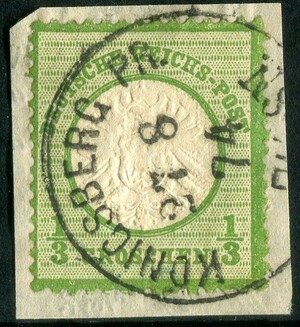SPECIALISING

SPECIALISING....
There comes a point where a collection of regular stamps becomes virtually complete, but certain sectors have a special affection. This is the time when specialisation becomes an interesting and challenging way to continue the hobby.
If you already have the second section (the specialised part) of our Germany list (Part 2 is 1872 Eagles through to Germanias and WWI), then you have already begun. The stamps of Germany proper fall into three main groups for the period up to the end of WWI:
1872 EAGLES
This is THE classic period, elegant stamps, dearly loved by many collectors in Germany, and therefore relatively costly, but where quality has held its value over generations. The existence of two currencies shows the unification of the German Reich was still in progress. Shades and small varieties have always been studied carefully, although the possibilities are not eye-catching as the stamps were printed with great care and due diligence at the Prussian Berlin Staatsdruckerei. Strips and blocks are possible. The stamps used on cover offer far more fascinating study, as the postal rates remained quite complex, with different costs between various former states or local districts, and various rates to neighbouring or distant countries before UPU simplification. The Michel specialised catalogue gives an excellent array of rate information. Other striking (but more expensive!) highlights to a collection would be mixed franking of former States with German Eagles, or French stamps plus Eagles for mail between Alsace-Lorraine and France. The Eagle illustrated here was cancelled at KONIGSBERG, once capital of Prussia until replaced by Berlin in 1878. Konigsberg, though heavily defended, became isolated and fell to advancing Russian troops in 1945. Despite the restoration of surrounding lands to Poland and Lithuania, it remains as an exclave of Russia today, renamed Kaliningrad (a submarine base),
1875-1900 PFENNIG/E/EAGLES
This quarter-century period is rather neglected by specialists, but volume of stamps used on mail began to increase, making unsorted lots cheaper, and more range of shades and small varieties.This was the period when Germany began to seek new colonies, and stamps of this period can be found "used abroad" in the new colonies before regular colonial issues came into use.
1900-1918 GERMANIAS
A striking design for the low values, and majestic printing for the Mark values. The economic growth of Germany between 1900 and 1914 meant many shades of identifiable printings, the widespread use of HAN print run numbers, two perforations types for the Mark values, and many other technical aspects for keen-eyed collectors. Shortages of personnel and materials during WWI led to a fall in print quality (wartime prints were often more heavily inked due to worn printing plates). British forgeries were produced (perhaps for planned propaganda mail or use by spies, but normally only found mint). And of course, these issues were widely used in the Colonies, suitably overpinted, and also overprinted for German Occupation on the Eastern and Western fronts during WWI. Booklets with combinations of se tenant values also appeared. Further issues continued after the war up to 1922, and are part of the Germania story, before being phased out by Worker, Posthorn and Numeral designs. So, Germanias are a huge field, mostly inexpensive and quite popular, it is just a matter of time, hunting, knowledge and organisation.
Of course, there are many other ways to specialise, but more of those topics in some later blogs....
- Published
- 19/06/21 12:24:00 PM
